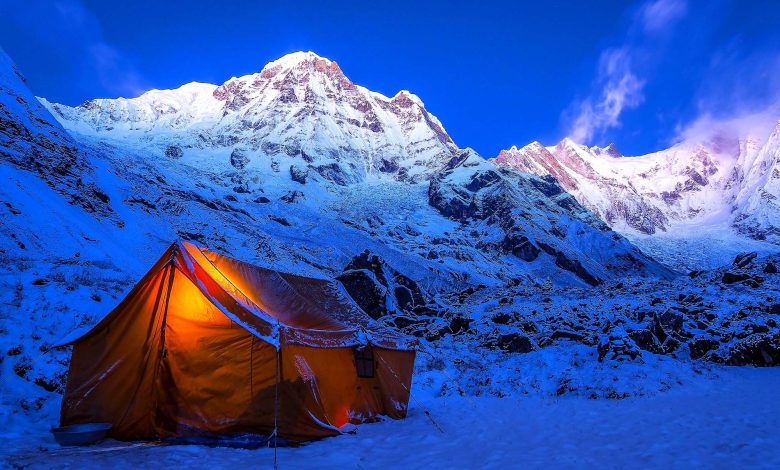All about the Annapurna Base Camp Trek

Introduction
The Annapurna Base Camp Trek in the Himalayas offers beautiful scenery, rich culture, and thrilling adventure. This journey in Nepal’s Annapurna region is a dream for hikers and environment lovers worldwide.
Annapurna’s towering peaks, rich forests, and different landscapes make it alluring. The hike through rhododendron forests, picturesque towns, and terraced fields showcases Nepal’s natural and cultural richness.
This amazing adventure requires careful planning. In this detailed guide, we’ll cover the Annapurna Base Camp hike’s geography, culture, ideal time to hike, and required gear. Prepare to be enchanted by Annapurna’s beauty and challenges on this magnificent trek.
Annapurna Region: A View
Nature enthusiasts and explorers enjoy Annapurna in north-central Nepal. Famous for its geographical richness, it covers 7,629 square km. The Annapurna and Dhaulagiri mountain ranges have stunning peaks, deep valleys, and lush foothills.
This area is biodiverse. Annapurna supports subtropical woods and alpine meadows. Naturalists and conservationists visit for its rich flora and fauna. The snow leopard and red panda live in conservation areas and national parks to preserve their unique ecosystem.
Annapurna is a cultural melting pot and natural wonder. Villages along the trekking trail are home to Gurungs, Magars, Thakalis, and others. Trekkers can experience the region’s rich culture by immersing themselves in each group’s traditions, dialects, and lifestyles.
On the Annapurna Base Camp Trek, you’ll see stunning scenery and meet the kind locals. This book covers the Annapurna region’s trekking schedule, optimum times to trek, permits, and more to help you plan your wonderful trip.
Annapurna Base Camp Trek Schedule
An itinerary is crucial to a successful Annapurna Base Camp Trek. Description of hike route and recommended number of days for a pleasant experience.
Overview of the trip Route: Depending on your schedule, the trip begins in Nayapul or Phedi and follows a well-trodden road through various landscapes. As you climb, you’ll pass picturesque settlements like Ghandruk, Chhomrong, and Deurali with varied views of terraced fields, rhododendron forests, and snow-capped summits. Annapurna Base Camp at 4,130 metres is the journey’s highlight. Annapurna I, South, Fishtail, and Hiunchuli tower over you.
Suggested Number of Days: The Annapurna Base Camp Trek should last 7–12 days, depending on fitness and preferences. Slower travel allows acclimatisation and exploration. Shorter routes may need longer daily walks, which might be strenuous.
Best Trek Time
Annapurna Base Camp Trek scheduling can greatly affect your experience. Seasons in Annapurna provide their own beauty and problems.
Seasons in Detail:
Autumn (September to November): Trekking is ideal in autumn (September–November). Weather is stable with bright skies and pleasant temps. The scenery are colourful and the snow-capped summits are stunning. Autumn is peak hiking season, so expect more people on the path and in teahouses.
Spring (March to May): Rhododendrons and other wildflowers bloom in nice weather, providing a colourful scene. These paths are less congested than fall, making them ideal for peaceful walking.
Winter (December–February): Despite cooler temperatures and snowfall, some trekkers choose winter. Winter beautiful, although cold might be difficult and some guesthouses may be closed.
Monsoon (June to August): The monsoon season (June–August) is less popular due to excessive rainfall and landslides. Trekking is unsafe during this time due to slick trails.
Different Season Trekking Pros and Cons:
Although popular, autumn and spring have the best weather and mountain views.
Winter and monsoon are pretty but have weather issues.
Regulations and Permits
Before starting the Annapurna Base Camp Trek, you must know the permissions and restrictions. These protect your safety, the environment, and local culture.
Required Permits and Fees:
Annapurna Conservation Area Permit (ACAP): Trekkers must get the Annapurna Conservation Area Permit (ACAP) to enter the area. As of January 2022, foreigners paid NPR 3,000 (about $30 USD) for a permit. The pricing may have changed since then.
Tims Card: Trekkers’ Information Management System Other permits are needed, although the TIMS card is mainly for Annapurna trekking. Individual trekkers paid NPR 2,000 (about $20 USD) for TIMS cards in 2022. Please check fees and requirements with authorities.
Environmental and Cultural Rules:
Honor local customs. Dress modestly and ask permission before photographing people or property. Take away trash and walk responsibly to reduce your environmental effects.
Stay in designated campgrounds and motels to help local communities and the environment.
Respect wildlife conservation efforts and don’t harm local wildlife.
Physical Prep
The Annapurna Base Camp Trek is strenuous, therefore preparation is essential for safety and enjoyment. These recommendations will prepare hikers of all levels:
- Cardiovascular Fitness: Himalayan trekking requires long walks at high altitudes. Hiking, brisk walking, jogging, and cycling improve cardiovascular fitness. Strive for stamina.
- Strength Training: Build leg, core, and upper body strength to handle uneven terrain and backpack weight. Good exercises include squats, lunges, planks, and push-ups.
- Acclimatisation: Gradual climb prevents altitude sickness. To acclimatise, plan acclimatisation days at higher altitudes on your expedition.
- Mental Preparedness: Altitude trekking is mentally demanding. Develop positivity and mental resilience to face challenges.
- Check Your Health: Before the trek, talk to your doctor about immunisations, drugs, and altitude sickness avoidance.
- Practise trekking: Go on short hikes or day trips to get used to it.
Conclusion
Reaching Annapurna Base Camp is awe-inspiring. The charm of this walk becomes apparent as you stand in the shadow of Annapurna I and the beautiful Himalayas.
Travelling in Annapurna will leave you with lifelong memories. This walk is life-changing, from the welcoming local villages to the peaceful self-discovery and stunning sunrises and sunsets.
Remember your challenges, natural beauty, and friendships after your Annapurna Base Camp Trek. This illustrates human resilience and nature’s beauty. This book should inspire and prepare you for this great adventure. Start this unforgettable Himalayan trip.




